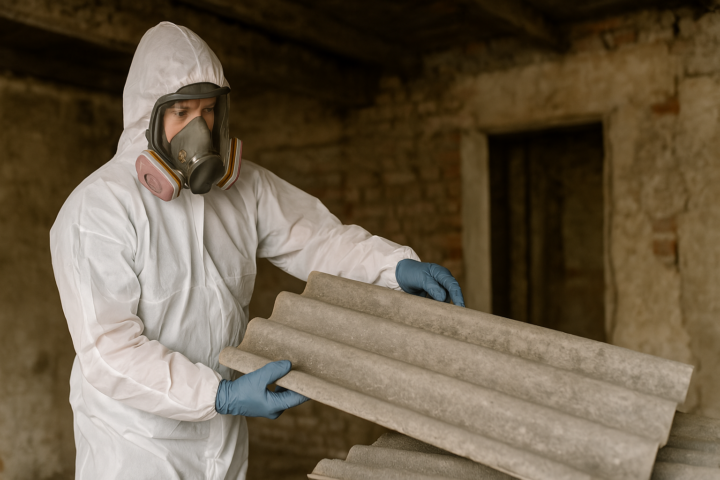The following contribution is from another author.
Think asbestos is a thing of the past? A problem long gone, dealt with decades ago? Not quite.
Despite being banned in many countries and tightly regulated in others, asbestos is still around. In fact, it’s lurking in far more places than most people realise. And the danger doesn’t come from some obvious, crumbling industrial building. It can be hiding in plain sight within homes, schools, offices, and public buildings.
If you’re assuming this stuff disappeared with the 80s, it’s time to look again.
What is asbestos, really?
Asbestos is a group of naturally occurring fibrous minerals. It was once hailed as a wonder material. Fire-resistant, strong, durable, and cheap. It was used in everything from insulation and roofing to brake pads and cement. The problem? When asbestos fibres are disturbed and become airborne, they can be inhaled—and that’s when the real damage starts.
Prolonged exposure to asbestos fibres can cause serious health issues, including:
- Mesothelioma – a rare, aggressive cancer that affects the lining of the lungs or abdomen
- Asbestosis – scarring of the lungs that leads to breathing difficulties
- Lung cancer – asbestos is a known cause, particularly in those who smoke
- Pleural thickening – swelling and hardening of the lining of the lungs
These conditions don’t show up overnight. They often take decades to develop, which is why many people don’t connect the dots until it’s far too late.
Why is asbestos still a problem?
You might be wondering—if we know how dangerous it is, why is it still a concern? The answer lies in its legacy.
Asbestos was used extensively throughout the 20th century, especially in construction. That means any building built before the late 1990s could contain asbestos in some form. It could be hiding in ceiling tiles, pipe insulation, roof sheets, floor tiles, wall panels, or even textured coatings like Artex.
And while it’s true that asbestos is generally safe when undisturbed and in good condition, the moment it’s drilled, cut, sanded, or broken, the fibres can be released into the air. That’s where the risk lies. Renovation projects, repairs, even something as simple as installing a new light fitting, can suddenly expose the material.
It doesn’t help that asbestos isn’t easy to spot. It’s not one type of material. It was mixed into hundreds of products. Unless you know exactly what to look for—and have the tools to test it—it’s almost impossible to identify with the naked eye.
This is where experts like Cordtape Environmental Services come in. Trained professionals know how to recognise the signs, where to look, and how to test materials safely. Trying to figure it out yourself can be risky, especially if it means disturbing something that could release fibres into the air. When in doubt, always bring in someone qualified. It’s not worth the gamble.
The places asbestos is still hiding
Most people associate asbestos with factories or rundown industrial sites. But it’s not limited to those.
Here are five unexpected places where asbestos is often still found:
- Homes built before 2000 – especially those with old boilers, pipe lagging, or original floor tiles
- Schools and public buildings – asbestos was heavily used in education buildings due to fire safety standards
- Garage roofs and outbuildings – cement sheets and roofing materials commonly contained asbestos
- Ceiling coatings – decorative finishes and textured paints often contained white asbestos
- Old fuse boxes and wiring insulation – electrical systems from earlier decades may still house asbestos-based components
Just because a building looks clean or modernised doesn’t mean the asbestos has been removed. It’s common for it to remain hidden behind walls, under floors, or above ceilings.
Renovation work? Pause before you start
DIY has seen a major rise in popularity. More people than ever are renovating their own homes, taking on projects to modernise or expand older properties.
But here’s the problem: most DIYers don’t realise they could be disturbing asbestos when they drill into a wall or rip up old flooring. And even professional contractors can miss the signs if a proper asbestos survey isn’t done first.
This isn’t about creating fear. It’s about creating awareness. The worst thing about asbestos exposure is how avoidable it can be when people have the right information.
The law and responsibility
In many places, the law is very clear about who is responsible for managing asbestos risks. Property owners, landlords, and employers all have legal duties to ensure that asbestos-containing materials (ACMs) are properly identified and maintained.
This usually means having an asbestos survey carried out and keeping an asbestos register up to date. If asbestos is found, it doesn’t always have to be removed. Sometimes, it’s safer to leave it in place and manage it. But if there’s a risk of damage or disturbance, then professional removal may be necessary.
What’s important is that no work involving asbestos is carried out by anyone who isn’t trained and qualified to do so. The risks are too high to take shortcuts.
What to do if you suspect asbestos
If you’re unsure whether a material contains asbestos, don’t touch it. Don’t try to remove it yourself. And definitely don’t start drilling, sawing, or sanding it.
Instead:
- Arrange for a qualified asbestos surveyor to inspect the area
- Make sure you get lab testing done before disturbing any suspicious material
- If asbestos is confirmed, get professional advice on whether it needs to be removed or managed in place
In workplaces or rented properties, raise concerns with the appropriate person, whether that’s a manager, landlord, or property owner. They have a legal obligation to deal with it appropriately.
So, is asbestos still dangerous?
Yes. But the real danger lies in not knowing it’s there.
The presence of asbestos doesn’t automatically mean a building is unsafe. But ignorance, or worse—carelessness—can turn a manageable risk into a serious health hazard. It’s why awareness is still so important. Because once fibres are in the air, there’s no easy fix.
No one wants to think that something as simple as a home improvement job or moving into an older building could have life-altering consequences. But when it comes to asbestos, that’s exactly what’s at stake.
















